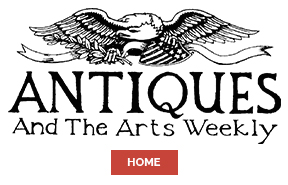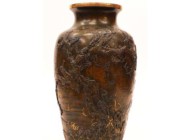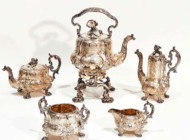
This Eighteenth Century wool embroidered panel won the auction’s highest price, multiplying its $800-$1,200 estimate to $10,625.
Review by Z.G. Burnett
BELLOWS FALLS, VT. — Augusta Auctions hosted the first round of deaccessioned textiles, antique garments and vintage couture from the Brooklyn Museum’s collection on April 16. This collection included American, European and Asian treasures from the Sixteenth through the late Nineteenth Centuries and represented most of the catalog’s 250 lots. Garments from the International Quilt Museum at the University of Nebraska-Lincoln were also offered, including quilts dating from the Eighteenth to the early Twentieth Century. More than 95 percent of the listings were sold, with many far exceeding their estimates, amounting to a total realized of $156,212 for this auction.
Antique textiles won some of the auction’s highest prices, led by an embroidered wool picture, made in England circa 1740. It showed a polychrome woodland scene with a menagerie of skillfully rendered exotic beasts coexisting in a thicket of distinctly diverse plant and tree species. The panel was in very good condition with its back facing intact and some fraying on the edges, selling for $10,625.
Next in this category was a resplendent Nineteenth Century couched work from China, embroidered with an aviary of real and imagined birds, butterflies and foo dogs. Its base was pinstriped silk with some discoloration, pulls to the embroidery and tarnish on the goldwork, but the panel was still in good condition overall. It was one of two Chinese pieces in the top lots, more than doubling its $1,2/1,500 estimate to achieve $3,750. The second was a women’s patterned silk jacket from the same era with embroidered trim and silk Peking knot enclosures. It also showed button enclosures with foreign-made notions that read “M.S. & J.D. Double Gilt.” The jacket was bid to $1,750.

Made in the Nineteenth Century, this Chinese ladies’ jacket showed an interesting cultural exchange in its buttons, which were stamped “M.S. & J.D. Double Gilt;” it achieved $1,750 ($800-$1,200).
In 1941, the Brooklyn Museum constructed Eighteenth Century period exhibition rooms and used contemporary textiles for their trimmings. Reconstruction and conservation methods have changed considerably since then, but two prominent lots exemplified both textile and museum history. Two pairs of resist indigo dyed linen curtains with a fantasy acorn vine motif (four panels in total) fetched $3,125. These were in good condition, showing discoloration from light exposure and heavy wear to some of the trim, indicative of nearly a century of use. Another set of panels in the same condition were made of indigo thread dyed tabby weave silk with linen backings and valances with silk fringe. These were possibly woven in France and achieved $2,063.
Many vestments and ecclesiastical textiles came with the Brooklyn Museum’s consignment. The highest bid was a late Seventeenth Century Russian cover of silk or linen that was densely embroidered with gilt silver thread, showing a gilt silver foil fill cross at the center and Cyrillic inscription around its perimeter. Both edges were spangled with the same thread and the cover was bordered with gilt silver knotted fringe. Even in fair to good condition, it sold for $1,688. From Spain, a pink chalice veil from the same century and in fair condition followed closely behind in price at $1,438. Its central motif depicted a white dove surrounded by cherubs, flowers and scenes from the life of Jesus Christ embroidered in polychrome silk and couched gold threads. The veil also had an applied border of gold bobbin lace and was lined in light brown silk.
Like Augusta’s Vintage for Valentines auction on February 12 of this year, couture lots by Japanese designer Issey Miyake were in high demand among top bidders. Second in the sales overall was a black pleated Staircase dress from Miyake’s 2003 White Label line. The sculptural garment had both the distinctive skirt and inverted Staircase bodice and was in excellent condition, selling for $5,125 from a single bid. Following the dress in price was a Staircase skirt in shades of blue and black of the same approximate vintage and condition that achieved $3,875 after a volley of bids.

From Issey Miyake’s 2003 White Label couture line, one bidder won this Staircase dress for $5,125 ($2/3,000); a blue, cream and black example (not illustrated here) led Augusta’s February auction.
Two other Miyake ensembles exceeded their estimates. A black sheath dress made with pleated polyester fabric that was convertible into a few different silhouettes was bid to $1,688 against its $1,2/1,500 estimate. Next was a three-piece set of a dress, top and skirt in similar pleated polyester with an aqua, brown and purple pattern that was estimated at $800-$1,200 and sold for $1,625. These lots were also from the early 2000s and in excellent condition.
The earliest garment in the top lots was also the most intricate, especially compared with Miyake’s structural but comparatively minimalist creations. A circa 1894 two-piece evening gown from Charles Worth, Paris, exemplified the late Nineteenth Century’s renaissance revival style. Its dusty teal silk satin with woven ribbon and rose motif stripes comprised the bodice and outer skirt, decorated with ribbons, beaded and wrapped aiglettes, puff sleeves with faux panes and silk chiffon fillings. Other notions included chemical lace, a double layer of pink and blue double-faced silk satin ribbon that was knotted with crystal beaded drops and tassels over a crystal beaded ribbon pattern on the skirt’s fabric. The gown was in fair condition and meant only for display; it achieved $1,938.
Prices quoted with buyer’s premium as reported by the auction house. Augusta Auctions’ second BK Museum Textiles, International Quilt Museum & Vintage Store Stock Auction will be conducted online on June 18. For information, 802-463-3333 or www.augusta-auction.com.

















